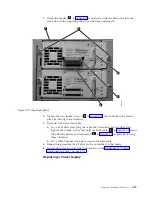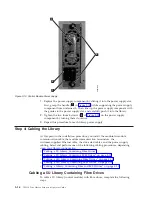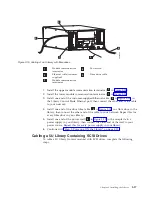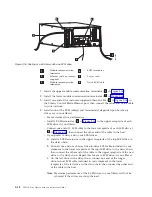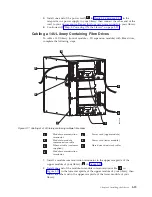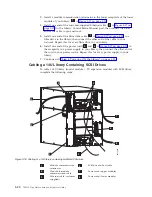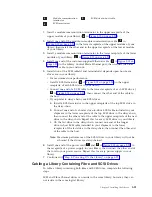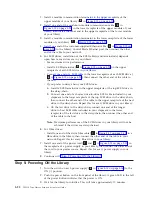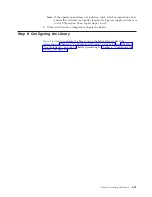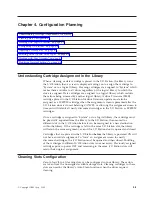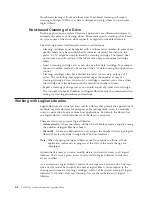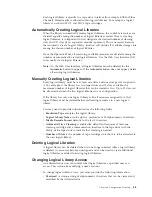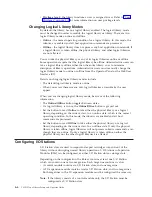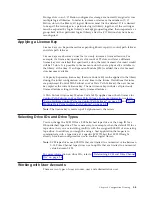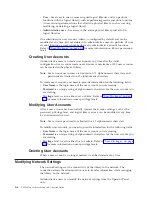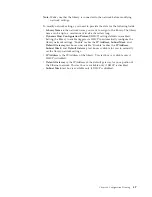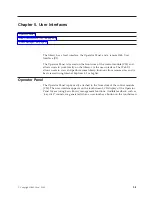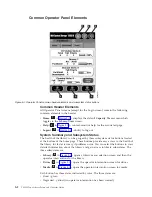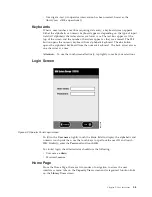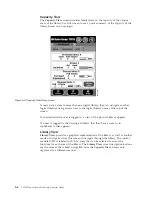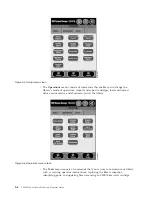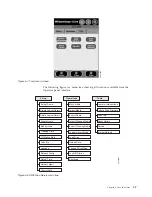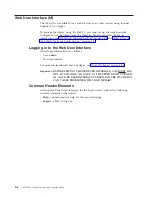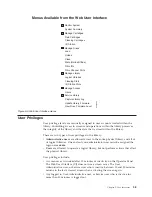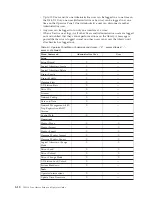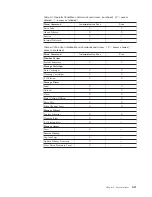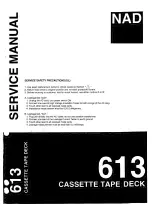
Storage
slots
in
an
I/O
Station
configured
as
storage
are
normally
assigned
across
multiple
logical
libraries.
In
order
to
increase
or
decrease
the
number
of
I/O
Station
slots
in
the
library,
all
logical
libraries
must
first
be
deleted.
If
it
is
desired
to
keep
all
the
cartridges
in
a
particular
logical
library
together,
all
the
cartridges
must
be
exported
by
logical
library
and
kept
grouped
together,
then
imported
as
a
group
back
to
that
particular
logical
library
after
the
I/O
Station
slots
have
been
reconfigured.
Applying
a
License
Key
License
keys
can
be
purchased
for
expanding
library
capacity,
control
path
failover,
and
data
path
failover.
License
keys
are
absolute
values
that
can
only
increase
a
licensed
feature.
For
example,
if
a
license
key
specified
a
slot
count
of
92
slots
and
later
a
different
license
key
was
installed
that
specified
46
slots,
the
total
licensed
slot
count
would
still
be
92
slots.
It
is
possible
to
license
more
slots
than
are
physically
available
in
the
library
at
the
time.
If
an
Expansion
Module
(EM)
is
added,
the
extra
licensed
slots
become
available.
A
Capacity
Expansion
license
key
(Feature
Code
1640)
can
be
applied
to
the
library
during
the
initial
configuration
or
at
any
time
in
the
future.
If
additional
features
are
purchased
(Control
Path
Failover
and/or
Data
Path
Failover),
the
new
license
key
replaces
the
current
license
key.
The
new
license
key
includes
all
previously
licensed
features
along
with
the
newly
licensed
features.
A
Path
Failover
license
key
(Feature
Code
1682)
supplies
one
or
both
licenses
for
Control
Path
Failover
and/or
Data
Path
Failover.
For
more
information,
refer
to
and
Note:
The
license
key
is
made
up
of
5
alphanumeric
characters.
Selecting
Drive
IDs
and
Drive
Types
You
can
change
the
SCSI
ID
for
a
SCSI-attached
tape
drive
or
the
Loop
ID
for
a
Fibre-attached
tape
drive.
This
is
necessary,
for
example,
when
the
default
ID
for
a
tape
drive
that
you
are
installing
conflicts
with
the
assigned
SCSI
ID
of
an
existing
tape
drive.
In
addition,
you
might
be
using
a
host
application
that
expects
to
communicate
with
a
tape
drive
at
a
specific
SCSI
ID,
but
that
SCSI
ID
might
already
have
been
configured
for
use
in
another
logical
library.
Note:
SCSI
tape
drives
use
SCSI
IDs
that
are
limited
to
a
numerical
value
between
0-15.
Fibre
Channel
tape
drives
use
Loop
IDs
that
are
limited
to
a
numerical
value
between
0-125.
For
more
information
on
drive
IDs,
refer
to
Working
with
User
Accounts
There
are
two
types
of
user
accounts:
user
and
administrative
user.
Chapter
4.
Configuration
Planning
4-5
Summary of Contents for System Storage TS3310
Page 1: ...IBM System Storage TS3310 Tape Library Setup and Operator Guide GA32 0477 00...
Page 2: ......
Page 3: ...IBM System Storage TS3310 Tape Library Setup and Operator Guide GA32 0477 00...
Page 6: ...iv TS3310 Tape Library Setup and Operator Guide...
Page 12: ...x TS3310 Tape Library Setup and Operator Guide...
Page 14: ...xii TS3310 Tape Library Setup and Operator Guide...
Page 22: ...xx TS3310 Tape Library Setup and Operator Guide...
Page 24: ...xxii TS3310 Tape Library Setup and Operator Guide...
Page 42: ...1 18 TS3310 Tape Library Setup and Operator Guide...
Page 54: ...2 12 TS3310 Tape Library Setup and Operator Guide...
Page 63: ...a66ug019 Figure 3 6 Rails installed in rack front view Chapter 3 Installing the Library 3 9...
Page 78: ...3 24 TS3310 Tape Library Setup and Operator Guide...
Page 86: ...4 8 TS3310 Tape Library Setup and Operator Guide...
Page 98: ...5 12 TS3310 Tape Library Setup and Operator Guide...
Page 106: ...6 8 TS3310 Tape Library Setup and Operator Guide...
Page 220: ...11 22 TS3310 Tape Library Setup and Operator Guide...
Page 226: ...12 6 TS3310 Tape Library Setup and Operator Guide...
Page 236: ...A 10 TS3310 Tape Library Setup and Operator Guide...
Page 240: ...B 4 TS3310 Tape Library Setup and Operator Guide...
Page 266: ...F 8 TS3310 Tape Library Setup and Operator Guide...
Page 273: ......
Page 274: ...Part Number 95P2271 Printed in USA GA32 0477 00 1P P N 95P2271...

